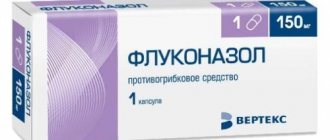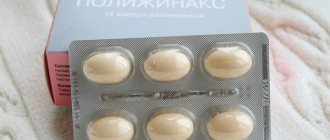Briefly about the disease
Candidiasis (the medical name for thrush) is caused by opportunistic fungi of the genus Candida. They actively multiply in the human body when immunity is reduced, antibiotics are used, or due to other factors. All types of candidiasis are treated with Fluconazole or other antifungal (antifungal) drugs of systemic and local action. Additionally, immunostimulating and antimicrobial agents and multivitamins are prescribed. Next, it is advisable to carry out drug prevention of thrush.
special instructions
Special instructions:
- Therapy should be continued until complete clinical remission occurs . Early refusal to take the drug can lead to relapse.
- During therapy, it is necessary to monitor blood counts and check how the kidneys and liver are working. If their pathology is detected, you must stop taking this medication.
- The hepatotoxic effects of Fluconazole are almost always reversible and disappear if the drug is discontinued.
- When treating AIDS patients , a skin rash sometimes appears, this serves as a signal to discontinue this drug. Compliance with all standards of therapy is required when using Fluconazole in combination with Rifabutin, Cisapride.
- When treated with antibiotics, not only pathogenic microflora is destroyed, but also beneficial ones. As a result, rapid growth of fungi such as cand may occur >
About 70% of women suffer from genital candidiasis (thrush), in addition, a small percentage of children and men are susceptible to the disease. Pathology occurs when Candida fungi, which are part of the microflora of the genital organs, begin to actively multiply. Treatment of thrush with Fluconazole is carried out in cases where a person develops characteristic burning, itching in the perineal area and whitish discharge with a curd-like consistency, and urination brings discomfort.
Briefly about the drug
Fluconazole is prepared in capsules, tablets and solutions for infusion. The pharmacy chain sells medicine from manufacturers in the CIS countries, China, Israel and Europe. The active component of the drug is fluconazole. It belongs to the antifungal substances and is used in the treatment of diseases caused by yeast-like fungi of the genus Candida, as well as for the prevention of relapses of thrush. Fluconazole is also used in the complex treatment of mycoses of the skin, nails, scalp, beard and other pathologies caused by Cryptococcus, Sporothrix, Histoplasma.
Contraindications
The use of the drug is contraindicated in case of individual intolerance to the main component by the patient or high sensitivity of the body to the group of triazoles. Use is contraindicated when used simultaneously with the following drugs:
- terfenadine (a medicine to treat allergies);
- cisapride (a medicine intended to treat gastrointestinal disorders);
- astemizole;
- pimozide;
- chymidine;
- erythromycin.
In some cases, the use of the drug is contraindicated in childhood.
The drug should be taken with caution in case of renal and liver failure. Drugs that are actively processed by the liver cannot always be used simultaneously with fluconazole. In rare cases, damage to liver cells has been observed when taking fluconazole.
Drug prevention of thrush with Fluconazole
Overgrowth of yeast-like fungi of the genus Candida is difficult to stop when a person is forced to take antibiotics or other medications for a long time. It is also difficult for a patient to get rid of candidiasis if he has been diagnosed with an immunosuppressive state, HIV, or AIDS. To prevent thrush, you should periodically take Fluconazole or another antifungal drug. The treatment regimen is developed by the attending physician. It takes into account the person’s age and weight, the severity of concomitant diseases, and drug interactions with other complex therapy agents.
Important
After treating candidiasis, doctors often recommend taking Fluconazole as a preventive measure for the disease. The drug must be taken strictly according to the schedule calculated by the doctor, preferably at night: dizziness and other possible side effects will disappear by the morning. It is important to remember that for people with impaired renal or liver function, the single dosage of the medication is reduced by half.
Sources:
Vidal : https://www.vidal.ru/drugs/vero-fluconazole__10369 GRLS : https://grls.rosminzdrav.ru/Grls_View_v2.aspx?routingGu >
Found a mistake? Select it and press Ctrl + Enter
source
Prevention of candidiasis in women
When planning to conceive a child, a woman and her sexual partner must first prevent thrush, as well as other genital infections. This will protect the baby from infection inside the womb or during birth.
Women who have undergone treatment for thrush are recommended to use Fluconazole for future prevention. A person does not develop immunity after a fungal infection, so there is a high risk of becoming re-infected with the pathogen. Doctors also note an increased incidence of chronic thrush. In women it often recurs. Periodic use of the medicine will prevent the exacerbation of candidiasis, or stop its new development in case of re-infection with a fungal infection.
Classic regimens for taking Fluconazole for the prevention of thrush in women:
- Women with a chronic or generalized form of candidiasis, with diabetes, cancer, HIV or other immunosuppressive conditions are prescribed 50-400 mg of Fluconazole once a month to prevent recurrence of thrush. The drug is taken throughout the year. The exact dosage and duration of the course are selected depending on concomitant pathologies and the magnitude of the risk of exacerbation of the disease;
- For women undergoing antibiotic therapy or other drug treatment, the doctor may prescribe a single dose of 150 mg of Fluconazole to prevent thrush;
- The drug should not be used during pregnancy . To prevent thrush, instead of Fluconazole, gynecologists-obstetricians recommend vaginal suppositories Pimafucin, Epigen spray and similar topical agents. Medicines containing fluconazole are used only for the treatment of severe fungal infections from the third trimester according to an individually selected treatment regimen!
- Fluconazole is not used during lactation . If the doctor has prescribed the prevention of thrush with this remedy, then stop breastfeeding while taking the medicine and 5-7 days after the end of the course. According to the standard regimen, to prevent candidiasis during lactation, a woman is prescribed a single dose of 150 mg of Fluconazole. If necessary, the drug is repeated once a day for three days in a row or after 1-2 weeks.
A couple needs to use barrier contraceptives when a doctor prescribes Fluconazole for the purpose of prevention. Women stop using hormonal OCs because they provoke the development of fungi. Preventing pregnancy through condoms is mandatory. In case of accidental conception, the active substance fluconazole disrupts the formation of the embryo in the early stages, so the drug can cause congenital anomalies of the child.
Overdose
If the drug is used for a long period of time, as well as in doses not allowed by the instructions, symptoms of overdose may develop. They manifest themselves in the form of intoxication of the body.
The patient experiences nausea, progressing to vomiting, loose stools, increased sweating, pallor or bluish skin. In severe cases, spatial orientation is disrupted, speech confusion, hallucinations, convulsions, and loss of consciousness appear.
If the overdose is accompanied by severe consequences, then the patient undergoes further treatment in a hospital, where he is prescribed hemodialysis, which helps to lower the concentration of Fluconazole in the bloodstream. Therefore, Fluconazole must be taken strictly as prescribed by the doctor.
Prevention of candidiasis in men
Thrush rarely develops in men - their microflora on the genital organ is not subject to frequent imbalances due to hormonal fluctuations. In most cases, they can be prescribed Fluconazole to prevent candidiasis if this pathology is detected in a sexual partner, or the couple is planning to have a child. Doctors also prescribe the drug for chronic forms of the disease or the presence of diseases that suppress the human immune system.
How to take Fluconazole to prevent thrush in men:
- According to the standard regimen, to prevent candidiasis, the doctor prescribes 50-400 mg of Fluconazole, depending on the magnitude of the risk of developing the disease;
- For chronic candidiasis, for the purpose of prevention, a man drinks 150 mg of Fluconazole every three days. For one course he must take 2, 3 or 5 tablets/capsules;
- If a sexual partner is diagnosed with thrush, the doctor prescribes a single dose of 150 mg of Fluconazole orally to the man. For prophylaxis, the drug is taken again after 7 days;
- If a man is ill with genital candidiasis, for treatment he is prescribed a single loading dose of the drug orally (150-400 mg), and an ointment with the substance fluconazole for external use. To prevent recurrence of thrush, Fluconazole 100 mg once a week for four months or 150 mg every 30 days can be prescribed.
These are common regimens for preventing thrush in men. But doctors select the dosage taking into account the form of the previous illness, concomitant pathologies and other individual indicators of the patient. Fluconazole should not be taken on its own. An incorrectly selected dose may cause the fungus to lose sensitivity to the drug and/or cause side effects.
Indications
This dosage form can be used in the treatment of any fungal pathologies, and can be used as an additional or primary remedy.
Fluconazole is used in the treatment of the following diseases:
Pathological processes that are caused by a fungus such as candida. As well as other types of invasive candidiasis.
- Candidiasis, which develops damage to the mucous membranes of the mouth, esophagus, and nasopharynx.
- Atrophic oral candidiasis, which occurs due to the use of dentures.
- Urogenital candidiasis (vaginal).
- Meningitis, the etiology of which is cryptococcal infection.
- Dermatomycosis, which affects the feet, groin, and the whole body.
- Endemic mycoses.
- Onychomycosis and pityriasis versicolor.
- After radiation therapy (for prophylactic purposes).
Prevention of candidiasis in children
In infants and children of a younger age group, thrush on the oral mucosa is more often diagnosed. These forms of the disease are usually treated with antifungals not from the fluconazole class. A child over one year old is allowed to be given medications of this group for the prevention of candidiasis only under strict indications! But if the development of a fungal infection threatens the baby’s life, then the drug is prescribed even to infants.
Possible regimens for taking Fluconazole for the prevention of thrush in children:
- A child weighing more than 50 kg is allowed to give an adult dosage, but not higher than 400 mg/day. Doctors often recommend taking Fluconazole 150 mg once for prevention against thrush;
- A child weighing less than 50 kg should be given a single dose of 50 mg of the drug, or at the rate of 3-6 mg/kg/day. To prevent genital thrush, Fluconazole is supplemented with external agents containing the substance fluconazole;
- Children at risk (cancer patients, HIV, tuberculosis, etc.) are given Flucanizole at a rate of 5-12 mg/kg/day. The drug is used to prevent thrush or other fungal infections in connection with taking medications and after chemotherapy.
In pediatrics, drugs containing fluconazole are used only for strict health reasons. They are prescribed mainly to children undergoing chemical or radiation therapy, who have AIDS, HIV infection or generalized forms of diseases caused by fungal infections. Parents should not give this medicine to their child without a doctor's prescription.
Side effects
This medication is almost always well tolerated, and no side effects are observed. But sometimes a negative effect may occur due to intolerance to the components of this remedy.
It can manifest itself in the form of sudden attacks of headache, the appearance of skin rashes, and dyspeptic disorders.
Also, adverse reactions can occur in various organs of the human body.
- From the nervous system, the patient may experience periodic headaches, drowsiness or insomnia, and seizures.
- In the cardiovascular system , a malfunction may occur in the form of the appearance of ari class=”aligncenter” width=”450″ height=”429″[/img]
- From the digestive system, there may be a decrease in appetite, dryness of the oral mucosa, paroxysmal pain in the lower abdomen, nausea, which sometimes turns into vomiting.
- Anemia and thrombocytopenia may rarely develop in the hematopoietic organs
- With long-term treatment, there is a high probability of allergies , which manifests itself as skin itching, facial swelling, hypersalivation, and sore throat.
- Very rarely, the use of this medication can cause kidney failure and the development of alopecia.
- It should be borne in mind that side effects appear much more often in children than in adults, and their most important feature is the development of anemia.









